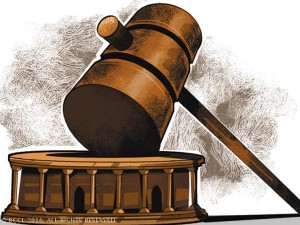In this blog post, Harsha Asnani, student, NIRMA University, Ahmedabad writes about class action suits. The author also discusses the reasons why class action suits are taken as a legal recourse and the applicability of class action suits in India through the way of Companies Act, 2013.
Introduction
Class Action Suits refer to lawsuits in which one or more group of persons or plaintiffs file a case on behalf of a large number of injured parties, commonly referred to as the ‘class’. Class Action Suits are also known as multi-district litigation and mass tort litigation. These types of suits are filed in cases of consumer frauds, securities frauds, misconduct in corporate or employment related practices or in cases where injuries have been caused due to the use of defective products, medical drugs motor vehicles, etc. Class Action Suits in employment-related matters of may be filed where the employees have suffered from discrimination by age, gender or race, etc. These multi-party suits can also be made in cases of a massive accident where people have suffered widespread personal injuries due to a defective product.
Why Class Action Suits are taken as a Legal Recourse
Class Action Suits are taken up as a legal recourse in cases where a large number of persons have suffered similar injuries. It is possible that the injuries to individual persons are relatively smaller, and the aggrieved party may not find it desirable to file a case on an individual basis. Instead, if all these cases are combined, it would become expedient to do so.
One of the major benefits of class action suit lies in its efficiency. Its practical implementation brings together hundreds of cases, which if dealt in the ordinary fashion, would consume a major chunk of court’s time and therefore diverting their attention from cases that require more attention. The decision that the Judge arrives upon, if decided in the favor of the defendant, prohibits the plaintiffs from filling any case over the same issue whereas if the representative plaintiff wins then, the defendant becomes liable for paying compensation. The amount, later on, gets transferred to the individual plaintiffs.
Class Action Suits become desirable in cases where the defendant party enjoys a higher status quo, and it becomes impossible for an individual plaintiff to institute a case against the other party in spite of suffering from grave injuries.
Due to aggregation of various petitions, the amount of cost involved in the entire litigation procedure falls drastically. Such suits further ensure that each party to the suit gets certain benefits. The amount so received may be less than the actual loss suffered. The decision of the court in the case concerned becomes binding on all the parties irrespective of whether they have attended the proceedings or have participated in the lawsuit. Where the parties agree to settle, the Judge needs to make sure that such an agreement proves to be fair for both the parties
Potential persons who may be affected due to the decision of the court in the class action are notified about the commencement of the suit. The court of appropriate jurisdiction instructs the class representative to take reasonable steps to inform all such persons about the suit. The people so informed have an opportunity to opt in or opt out of the case. It is noteworthy that class actions suits, unlike ordinary suits, involve a higher degree of research. Gathering of evidence is a tedious task in such suits.
Class Action Suits in India
In the Indian set up Class Action, Suits are not understood in the strictest sense as in the U.S. legal framework. The Indian Judiciary has relaxed the locus standi in certain cases especially in matters that are filed under Article 32 and 226 of the Indian Constitution. These cases include circumstances where a substantial question of human rights is involved. In addition to this, another instance where India had witnessed a suit in lieu with class action suits was in the case of Bhopal Gas tragedy.
In this case, the Government of India, by acting as the parens patraie, aggregated the claims of all the victims and initiated a legal proceeding against the Company firstly in India and then in New York.
Class Action Suits under The Companies Act, 2013
Class Action Suits have been formally recognized under the Indian regime after enactment of Companies Act, 2013 vide Section 245.
Who can File Class Action Suits?
Companies Act, 2013 empowers two classes of persons to file class action suits:
- Members
In case of companies having shares;
- Not less than one hundred members of the company;
- Not less than 10%of the total members or whichever is less;
- Any member or members singly or jointly holding not less than 10% of the issued share capital of the company.
In case of Companies not having share capital, not less than one-fifth of the total members.
- Depositors
- Number of depositors to be not less than one hundred;
- Not less than such percentage of the total number of depositors as it may be prescribed;
- Any depositor or depositors to whom the company owes such percentage of total deposits of the company as may be prescribed
Against whom can the claim be filed
A class action suit can be filed against:
- Company,
- Any of its directors,
- Auditor,
- Expert, advisor, consultant, etc.
What Remedies can be Claimed?
Any member or depositor on behalf of such members or depositors may file a Class Action Suit. Following are the remedies that can be sought before the National Company Law Tribunal (NCLT):
- Restrain the company from committing an act which is beyond the powers of the articles or memorandum of association of the company;
- Restrain the company from committing breach of any provision of company’s memorandum or articles;
- To declare a resolution as void for altering the memorandum or articles of the company or passed by suppression of the material facts or obtained by misstatement to the members or depositors;
- To restrain the company and its directors from acting on such resolutions;
- Restrain the company from committing any acts which are contrary to the provisions of the Act or any other law for the time being in force;
- Restrain the company from taking action contrary to any resolution passed by its members;
- Claim damages or compensation on demand any other suitable action against:
- The company or its directors for any fraudulent, wrongful or unlawful act;
- An auditor including audit firm of a company for any improper or misleading statement of particulars made in the audit report or for any unlawful or fraudulent conduct.
- An expert or advisor or consultant for an incorrect or misleading statement made to the company.
Functions of the Tribunal
On the receipt of any such application following are the factors that the Tribunal should take into consideration:
- Whether the member or depositor is acting in good faith in making the application for seeking an order;
- Any evidence before it as to the involvement of any person other than directors or officers of the company on any of the matters provided in clauses (a) to (f) of subsection (1);
- Whether the cause of action is one which the member or depositor could pursue in his right rather than through an order under this section;

- Any evidence before it as to the views of the members or depositors of the company who have no personal interest, direct or indirect, in the matter being proceeded under this section;
- Where the cause of action is an act or omission that is yet to occur, whether the act or omission could be, and in the circumstances would be likely to be—
- Authorized by the company before it occurs; or
- Ratified by the company after it occurs; (f) where the cause of action is an act or omission that has already occurred, whether the act or omission could be, and in the circumstances would be likely to be, ratified by the company
- Where the cause of action is an act or omission that has already occurred, whether the act or omission could be, and in the circumstances would be likely to be, ratified by the company.
 Serato DJ Crack 2025Serato DJ PRO Crack
Serato DJ Crack 2025Serato DJ PRO Crack










 Allow notifications
Allow notifications


